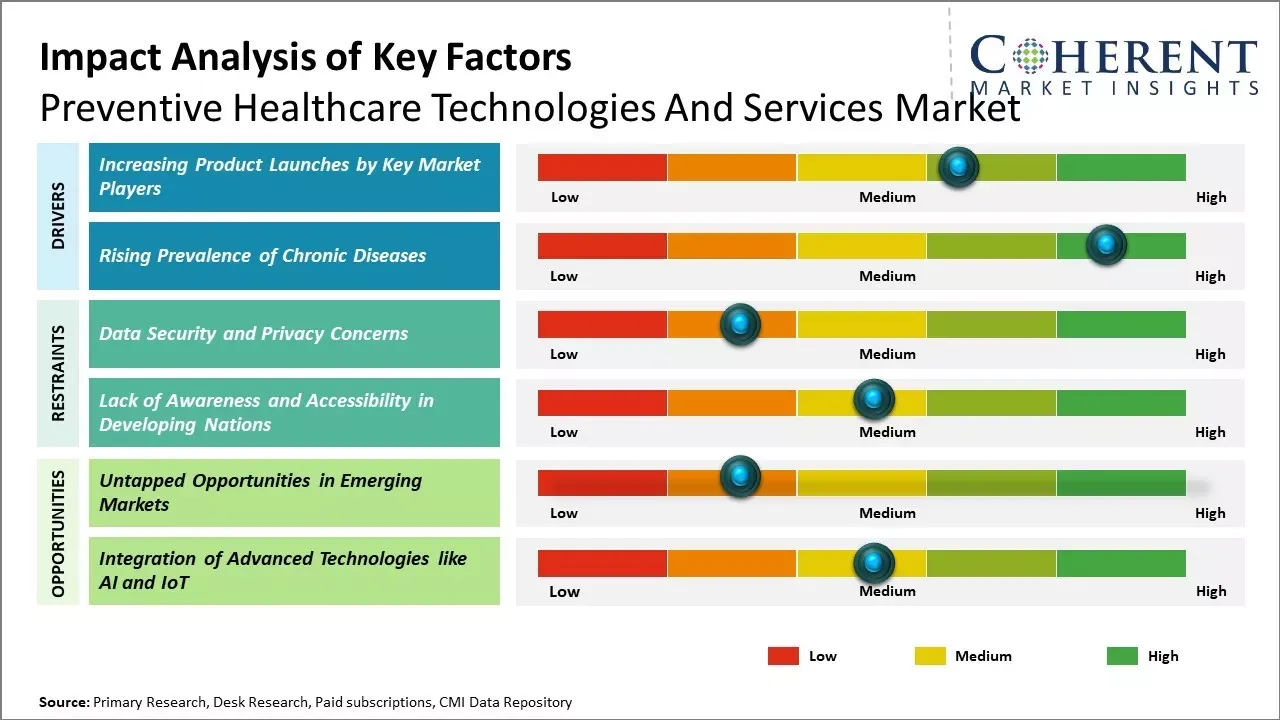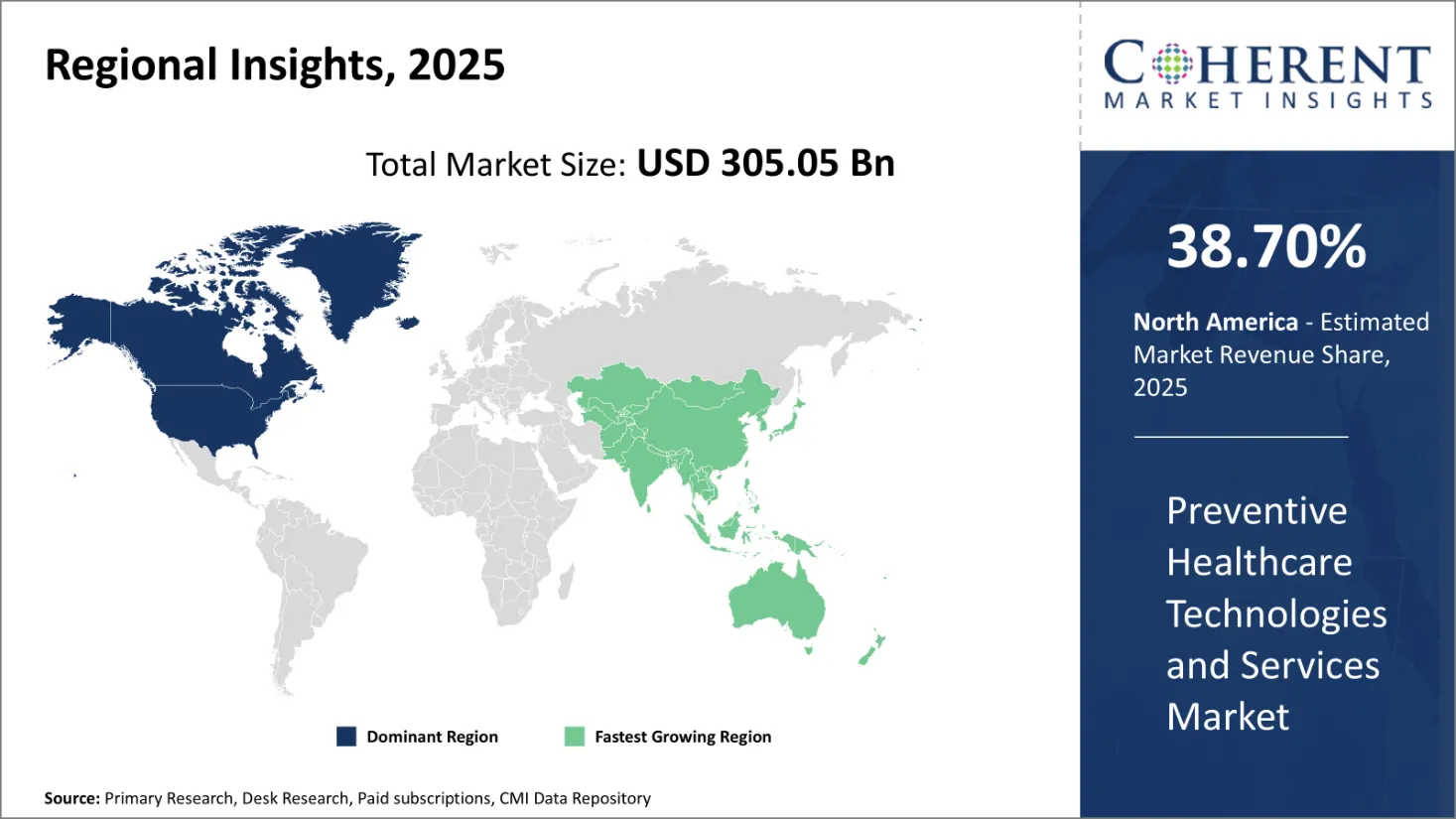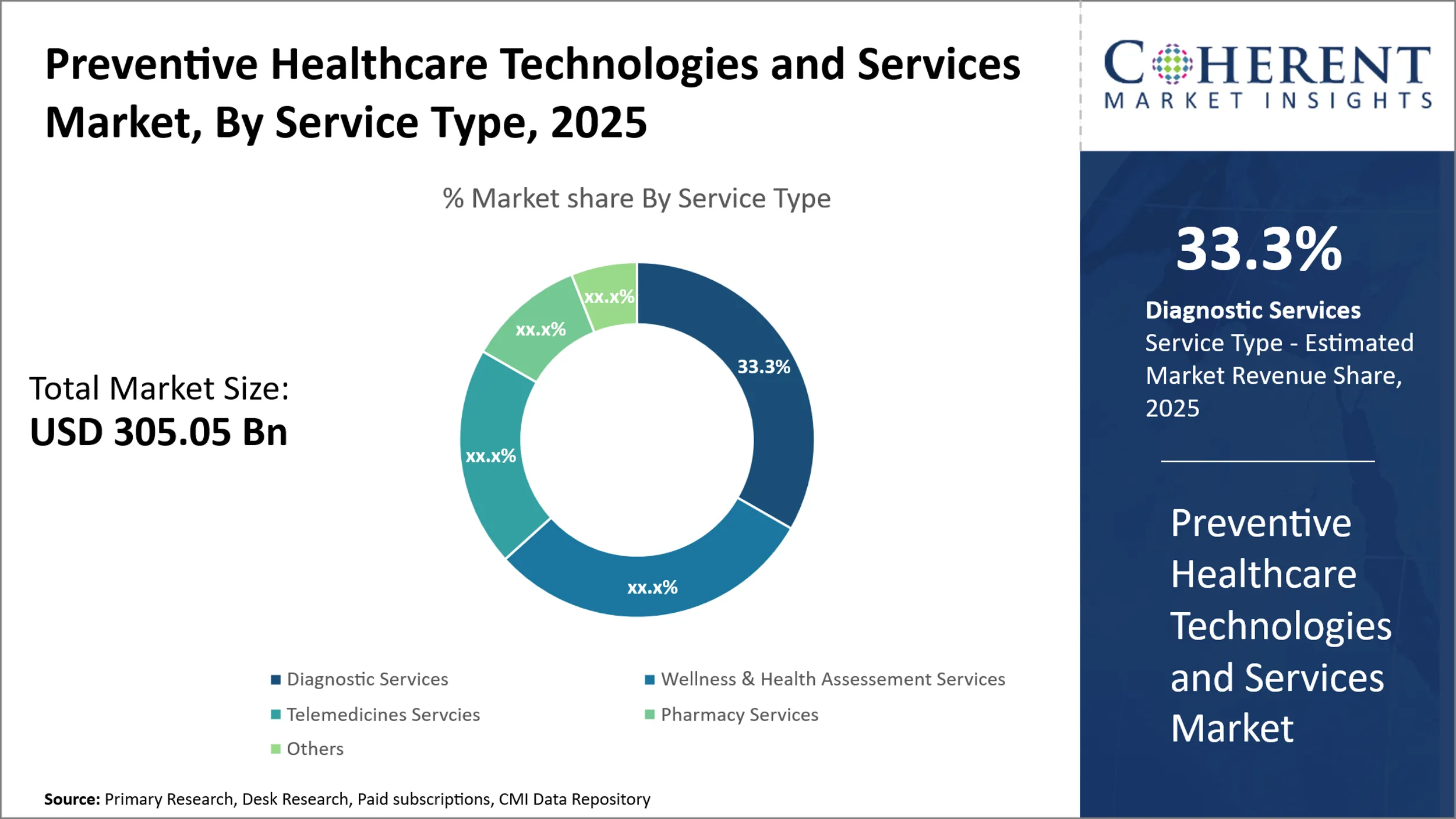Preventive Healthcare Technologies And Services Market Analysis & Forecast- 2025-2032
Preventive Healthcare Technologies And Services Market is estimated to be valued at USD 305.05 Bn in 2025 and is expected to reach USD 625.78 Bn in 2032, exhibiting a compound annual growth rate (CAGR) of 10.8% from 2025 to 2032.

To learn more about this report, Download Free Sample
Key Takeaways
- According to Service Type, The Diagnostic Services Category is anticipated to account for the largest share of 33.3% for the Preventive Healthcare Technologies And Services market in 2025. The efficiency of diagnostic services in preventative healthcare is being improved by the growing use of genome sequencing and individualized care strategies.
- According to Technology Type, The Telemedicine Segment is anticipated to hold 29.6% share of the Preventive Healthcare Technologies And Services market in 2025. Telemedicine makes preventative treatment more accessible, particularly in underserved and rural areas, by facilitating remote clinician consultations, early illness identification, and ongoing patient monitoring.
- According to end user, healthcare providers segment is expected to dominate 44.1% shares in the preventive healthcare technologies and services market in 2025. The target market is centered on healthcare providers, particularly hospitals and clinics. Hospitals dominate the market due to their ability to provide comprehensive care, but clinics are expanding quickly by utilizing individualized, data-driven preventative strategies.
- According to region, North America holds the largest market share of 38.7% for Preventive Healthcare Technologies And Services market growth by 2025. This region is at the forefront of incorporating innovations that enhance management, which includes telemedicine, genomic testing, AI-driven diagnostics, and mobile health solutions.
Market Overview
The Preventive Healthcare Technologies And Services Market Size is expanding rapidly due to a combination of factors such as growing public awreness of preventative health measures, technological improvements, and the prevalence of chronic diseases. The preventive healthcare technologies and services market is expected to witness significant growth during the forecast period. There is increasing focus among individuals as well as various countries to shift from current healthcare approach which is more reactive and disease centric, towards a preventive healthcare approach to reduce future healthcare costs and improve health outcomes.
For instance, in June 2025, In a major step forward in patient-centred preventative healthcare, Wockhardt Hospitals, Mira Road has officially launched its state-of-the-art wellness lounge. This premium facility is designed to provide a seamless, comfortable, and personalized environment for individuals undergoing routine health checkups and diagnostic evaluations.
Current Events and Its Impact on the Preventive Healthcare Technologies And Services Market
|
Event |
Description and Impact |
|
Integration of Industry 4.0 |
|
|
Expansion of Digital Health Platforms |
|
Uncover macros and micros vetted on 75+ parameters: Get instant access to report
Preventive Healthcare Technologies and Services Market Insights, By Service Type
In terms of service type, the diagnostic services segment is estimated to hold 33.3% of the market share in 2025 owing to the continuous technological advancements in the field of medical diagnostics.
Advanced diagnostic techniques such as molecular diagnostics, imaging, and pathology are gaining tremendous popularity due to their high accuracy and minimal invasiveness. Molecular diagnostic tests analyze genetic makeup and are widely used for detecting various types of cancer at an early stage. Further, non-invasive imaging technologies like MRI, CT scan, and X-ray provides sharp images of internal body parts without any surgery.
This has increased the patient preference for diagnostic tests over other invasive examination methods. Moreover, constant innovations in biomarker detection and liquid biopsy tests have enabled the detection of chronic disorders from simple blood or urine samples. The growing applications of AI and machine learning are also assisting in the automated analysis of diagnostic tests results.
Preventive Healthcare Technologies and Services Market Insights, By Technology Type
In terms of technology type, the telemedicine segment is estimated to hold 29.6% of the market share in 2025 owing to its ability to overcome geographical and time barriers in accessing healthcare.
Telemedicine allows remote clinical healthcare and consultation through video conferencing tools, mHealth apps, and telemonitoring devices. This has significantly benefited patients in rural areas and with limited mobility by minimizing traveling and waiting time. During the pandemic, telemedicine emerged as a safe alternative to physical visits and prevented overcrowding in clinics or hospitals.
Various government initiatives are promoting telemedicine to enhance healthcare penetration. For instance, several countries have implemented tele-ICU/tele-stroke programs to extend critical care services to remote regions. Moreover, the growing popularity of mHealth apps and wearable devices is complementing the expansion of telemedicine services.
Preventive Healthcare Technologies and Services Market Insights, By End User
The healthcare providers sub-segment is estimated to hold 44.1% of the market share in 2025 as they are actively adopting preventive healthcare technologies and services. Hospitals, clinics, diagnostic centers, and other providers are recognizing the vital role of preventive healthcare delivery in curbing healthcare expenditures.
Advanced technologies enable early-stage disease identification, timely intervention, disease management, and prevention of medical complications. For instance, providers are increasingly installing diagnostic equipment, telemedicine platforms, and patient engagement solutions.
Monitoring devices and mHealth apps are helping chronic patients to connect with clinicians remotely for medication reminders, appointment booking, and necessary care advice. This improves patient satisfaction while minimizing readmission rates. Providers also engage in various collaborations with payers and life science firms to broaden their technology-driven preventive service offerings.
Regional Insights

To learn more about this report, Download Free Sample
North America Preventive Healthcare Technologies And Services Market
North America remains the dominant region in the global preventive healthcare technologies and services market and is estimated to hold 38.70% of the market share in 2025. This can be attributed to a strong presence of leading technology companies and healthcare providers in countries like the U.S.
The region enjoys the early adoption of advanced healthcare solutions owing to high disposable income levels and favorable reimbursement policies supporting innovation. Further, the presence of major pharmaceutical players engaged in preventive healthcare adds to overall market strength. With focus on curbing rising healthcare costs, preventive care services see greater priority and private-public investments in this domain remain robust.
Asia Pacific Preventive Healthcare Technologies And Services Market
Asia Pacific represents the fastest growing regional market for preventive healthcare technologies and services. Rapid economic development across nations such as China and India has enhanced access to superior medical solutions. Rising healthcare expenditures and growing medical tourism industry provide opportunities for international players to expand market footprints in the region.
With a large patient pool and increasing health awareness, demand for preventive care is surging significantly. Local governments are promoting preventive services through public health programs and initiatives aimed at non-communicable diseases. This encourages the adoption of modern technologies and services even in rural pockets.
Preventive Healthcare Technologies And Services Market In Europe
The degree of investment in preventive care varies among European nations; Austria, Denmark, and the Netherlands have the highest levels of healthcare spending on prevention, while Germany, Sweden, and the UK have lower relative spending. Technological developments including wearable technology, digital health platforms, and predictive analytics are also helping the market by enabling more prompt and individualized preventive care.
Preventive Healthcare Technologies And Services Market Dominating Countries
U.S Preventive Healthcare Technologies And Services Market
The United States is the leading market for preventive healthcare technologies and services, driven by a well-established healthcare infrastructure, significant investments in digital health, and robust government support for preventive care.
India Preventive Healthcare Technologies And Services Market
India's preventive healthcare technologies and services market is expanding rapidly, propelled by rising health awareness, a growing burden of non-communicable diseases, and government initiatives aimed at early detection and vaccination. The country is witnessing increased adoption of digital health platforms, telemedicine, and mobile health solutions, especially in urban and semi-urban areas.
China Preventive Healthcare Technologies And Services Market
China is emerging as a dominant player in the preventive healthcare technologies and services market, supported by strong government policies, rapid urbanization, and significant investments in healthcare technology. The Chinese government has prioritized preventive care as part of its national health strategy, leading to expanded vaccination programs, increased health screenings, and integration of AI and big data analytics in public health initiatives.
Market Report Scope
Preventive Healthcare Technologies And Services Market Report Coverage
| Report Coverage | Details | ||
|---|---|---|---|
| Base Year: | 2024 | Market Size in 2025: | USD 305.05 Bn |
| Historical Data for: | 2020 To 2024 | Forecast Period: | 2025 To 2032 |
| Forecast Period 2025 to 2032 CAGR: | 10.8% | 2032 Value Projection: | USD 625.78 Bn |
| Geographies covered: |
|
||
| Segments covered: |
|
||
| Companies covered: |
Healthlane, Abbott, GSK plc, Myriad Genetics, Omron Healthcare Inc., Quest Diagnostics, Pfizer, Inc., Merck & Co., Inc., Omnicell, Novx Systems, Corp., U-Systems, Ltd., Viatronix, Inc., Scripto LLC, Lifecom, Inc., Dilon Medical Technologies, Inc., and McKesson Corporation |
||
| Growth Drivers: |
|
||
| Restraints & Challenges: |
|
||
Uncover macros and micros vetted on 75+ parameters: Get instant access to report
Preventive Healthcare Technologies and Services Market Growth Drivers
- Rising Prevalence of Chronic Diseases
The prevalence of chronic diseases has been rising at an alarming rate across the world. Chronic diseases such as cancer, diabetes, and heart disease are among the leading causes of mortality and morbidity globally. It is estimated that over 20 million new cancer cases were diagnosed and 10 million cancer deaths occurred in 2020 worldwide. Similarly, the number of people suffering from diabetes has risen from 108 million in 1980 to 422 million in 2014.
Major risk factors driving the rise in chronic diseases include rapidly aging population, increasing prevalence of obesity and sedentary lifestyles, growing consumption of tobacco and alcohol. Developed countries as well as developing nations are experiencing higher incidence of non-communicable chronic conditions. This rising disease burden puts tremendous pressure on national healthcare systems and budgets.
Preventive care helps reduce the occurrence of diseases and manages existing conditions in early stages before it progresses into more complex stages. Preventive healthcare technologies enable the early detection of risk factors, promotes healthy behaviors, and facilitates treatment adherence.
For instance, mobile health apps can track vital signs, diet, physical activity, and notify high-risk individuals. Genetic testing aids in identifying inherited predispositions. Wearable devices such as smart watches monitor heart rate and arrhythmias that can detect potential cardiovascular problems. Thus, the growing prevalence of chronic diseases worldwide is a major driver for the demand of preventive healthcare technologies as it provides means for screening, diagnosis, and management of at-risk population.
Preventive Healthcare Technologies and Services Market: Trends
- Increasing growth of food packaging industry in Asia Pacific is trending in the market
Asia Pacific has presence of large population pool, and the region is witnessing expansion of disposable income among customers, due to which food packaging industry is one of the major markets in the region. Moreover, technological developments across countries in the region are enabling premium food manufacturers to deliver unique food choices in long-lastingly and sustainable manner.
- Increasing digital transformation of enterprises around the world is a growing trend
Due to digital transformation of enterprises, the emergence of automation powered by digital technologies such as AI and robotics is increasing around the world. This is likely to help companies reduce cost of manufacturing. The use of robotic filling equipment allows packagers to create more than they can with manual product filling.
This technology can enable dependable, repeatable, and consistent fill with every cycle, whether the fill is based on a volume, level, weight, or another measurement. Thus, growing digital transformation of enterprises to fuel growth of the global Preventive Healthcare Technologies and Services market during the forecast period.
Preventive Healthcare Technologies and Services Market: Opportunities
- Increased Adoption of Telehealth and Remote Patient Monitoring
Untapped opportunities in emerging markets have a huge potential to boost the preventive healthcare technologies and services market globally. Countries like India, China, Brazil, and others in Asia Pacific and Latin America are still in the growth phase of establishing robust healthcare infrastructure and preventive care adoption.
With rising income levels, growing health awareness, increasing life expectancy and aspirations for better quality of life, people in these emerging economies are showing greater inclination towards preventive healthcare approaches.
Preventive Healthcare Technologies and Services Market: Key Developments
- In April 2025, Tokio Marine Holdings Inc launched its new subsidiary, Tokio Marine Healthcare Co Ltd, as part of its broader strategy to offer preventive healthcare services and support workplace health management across Japan.
- November 2024, Fujitsu developed Policy Twin, a new digital twin technology to simulate the social impact of local government policies. Fujitsu will start offering Policy Twin to support effective and efficient service delivery in municipal preventive healthcare services on via the Fujitsu Research Portal, Fujitsu’s environment that offers users the opportunity to try out Fujitsu's advanced technologies.
Analyst Opinion ( Expert Opinion)
- The market is being reshaped by rapid advancements in digital health platforms, artificial intelligence, and telemedicine, which are making early detection, personalized risk assessment, and timely intervention more accessible and effective than ever before. This technological evolution is not only improving patient outcomes but also driving efficiencies and cost savings for healthcare systems.
- There is a clear trend toward personalized and predictive healthcare, facilitated by the integration of genomics, big data analytics, and wearable health devices.
- As a result, screening and early detection services are expected to maintain the largest market share, reflecting their critical role in identifying health risks before they escalate into severe conditions.
Market Segmentation
- By Service Type
- Diagnostic Services
- Wellness & Health Assessment Services
- Telemedicine Services
- Pharmacy Services
- Others
- By Technology Type
- Telemedicine
- mHealth
- Health Information Technology
- Wearable Devices
- Others
- By End User
- Healthcare Providers
- Healthcare Payers
- Others
- By Region
- North America
- U.S.
- Canada
- Latin America
- Brazil
- Argentina
- Mexico
- Rest of Latin America
- Europe
- Germany
- U.K.
- Spain
- France
- Italy
- Russia
- Rest of Europe
- Asia Pacific
- China
- India
- Japan
- Australia
- South Korea
- ASEAN
- Rest of Asia Pacific
- Middle East
- GCC Countries
- Israel
- Rest of Middle East
- Africa
- South Africa
- North Africa
- Central Africa
- Company Profiles
- Healthlane
- Abbott
- GSK plc
- Myriad Genetics
- Omron Healthcare Inc.
- Quest Diagnostics
- Pfizer, Inc.
- Merck & Co., Inc.
- Omnicell
- Novx Systems, Corp.
- U-Systems, Ltd.
- Viatronix, Inc.
- Scripto LLC
- Lifecom, Inc.
- Dilon Medical Technologies, Inc.
- McKesson Corporation
Sources
Primary Research interviews
- Hospitals and Clinic Administrators
- Preventive Health Device Manufacturers
- Wellness Program Managers
- Public Health Officials
- Health Insurance Executives
- Medical Technology Startups
- Telehealth Platform Providers
Databases
- Scopus
- Web of Science
- Embase
- ClinicalTrials.gov
- WHO Global Health Observatory
- Healthdata.gov
Magazines
- Health Affairs
- Prevention Magazine
- Harvard Health
- Men's Health
- Women's Health
- Healthcare IT News
- MedTech Insight
Journals
- Journal of Preventive Medicine
- American Journal of Preventive Medicine
- BMC Public Health
- Preventive Medicine Reports
- Journal of Public Health
- The Lancet Public Health
- Journal of Health Communication
Newspapers
- The New York Times – Health Section
- The Guardian – Health
- The Hindu – Science & Health
- The Washington Post – Health & Science
- The Times of India – Health
- USA Today – Health
- The Wall Street Journal – Health
Associations
- World Health Organization (WHO)
- Centers for Disease Control and Prevention (CDC)
- American Public Health Association (APHA)
- National Institutes of Health (NIH)
- European Public Health Association (EUPHA)
- Indian Council of Medical Research (ICMR)
- International Association of Public Health Institutes (IANPHI)
Proprietary Elements
- CMI Data Analytics Tool, Proprietary CMI Existing Repository of information for last 8 years
Share
Share
About Author
Manisha Vibhute is a consultant with over 5 years of experience in market research and consulting. With a strong understanding of market dynamics, Manisha assists clients in developing effective market access strategies. She helps medical device companies navigate pricing, reimbursement, and regulatory pathways to ensure successful product launches.
Missing comfort of reading report in your local language? Find your preferred language :
Transform your Strategy with Exclusive Trending Reports :
Frequently Asked Questions
EXISTING CLIENTELE
Joining thousands of companies around the world committed to making the Excellent Business Solutions.
View All Our Clients


